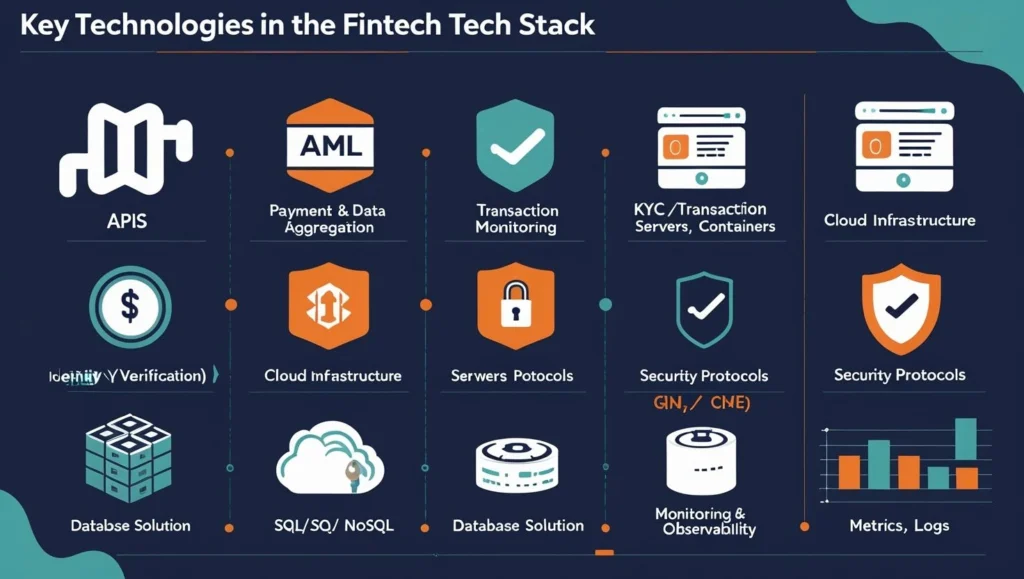Introduction
The fintech revolution shows no signs of slowing down—especially in the USA and Europe, where investor attention and regulatory frameworks fuel explosive innovation. For startups aiming to disrupt financial services, choosing the right tech stack is as critical as securing funding. A well‑crafted Fintech tech stack& product roadmap not only ensures compliance with AML and KYC regulations but also provides the scalability and security essential for long‑term success.
In this 7-step roadmap, we’ll guide you through selecting APIs, integrating tools like Stripe and Plaid, and architecting cloud infrastructure that can grow with your user base. You’ll learn what stack suits fintech, best practices for seamless integrate fintech tools, and how to leverage resources such as Finextra for the latest industry insights. By the end, you’ll have a clear blueprint to build a robust, compliant, and high‑performance fintech product.
1. Understanding the Fintech Tech Stack & Product
A fintech tech stack typically comprises:
- APIs for payments, data aggregation, and account verification
- AML (Anti‑Money Laundering) services to monitor suspicious transactions
- KYC (Know Your Customer) solutions for identity proofing
- Cloud infrastructure to host services securely
- Databases (SQL/NoSQL) for transaction records and user data
Compliance and customer trust are non‑negotiable. Every integration—whether it’s a payment API or a fraud‑detection engine—must meet stringent regulatory standards from Day One. Your roadmap should prioritize core services that protect user data while enabling rapid feature development.“Building a robust fintech tech stack roadmap ensures your startup can meet evolving regulatory demands.”
2. Key Technologies in the Fintech Tech Stack
2.1 Payment & Data Aggregation APIs
- Stripe
- Global payment processing with built‑in fraud detection and recurring billing
- Plugins for major frameworks (Node.js, Python, Ruby)
- Plaid
- Secure access to bank account data for account verification and balance checks
- Supports instant ACH transfers and user‑friendly authentication
Learn more on Finextra for in‑depth API reviews and integration case studies.

2.2 AML & Fraud Prevention Tools
- ComplyAdvantage and Elliptic for real‑time transaction monitoring
- Machine Learning models that flag anomalies, fed by historical data
- Sandbox environments to test AML rules before production rollout
2.3 KYC & Identity Verification
- Jumio and Onfido for automated ID document scanning and biometric checks
- OAuth 2.0 and OpenID Connect for secure user authentication
- Multifactor authentication (MFA) to prevent account takeovers
2.4 Cloud Infrastructure & Orchestration
- AWS, Azure, or Google Cloud for scalable compute, storage, and managed database services
- Containerization with Docker and orchestration via Kubernetes for microservices
- Infrastructure as Code (Terraform, CloudFormation) to version and automate deployments
2.5 Security Protocols & Best Practices
- End‑to‑end encryption (TLS 1.3) for all API calls
- Web Application Firewalls (AWS WAF, Cloudflare) to block common exploits
- Regular penetration testing and vulnerability scanning (OWASP ASVS)
- Role‑based access control (RBAC) and least privilege principles
2.6 Database Solutions
- SQL (PostgreSQL, MySQL) for transactional integrity and ACID compliance
- NoSQL (MongoDB, DynamoDB) for high‑velocity data ingestion and user session storage
- Data warehousing (Snowflake, BigQuery) for analytics and compliance reporting
2.7 Monitoring & Observability
- Prometheus and Grafana for real‑time metrics
- ELK Stack (Elasticsearch, Logstash, Kibana) for log aggregation and analysis
- Sentry or Datadog APM for error tracking and performance insights
3. How to Integrate Tools in Your Fintech Stack
Integrating third‑party fintech tech stack tools must be seamless and secure:
- Sandbox First: Always develop against sandbox endpoints—Stripe and Plaid both provide test environments.
- API Versioning: Lock to specific API versions to prevent breaking changes.
- Automated Testing: Write integration tests for transactions, edge cases, and error handling.
- Security Audits: Conduct code reviews and static analysis (SAST) for injected vulnerabilities.
- Scalability Checks: Load test your API calls to ensure they handle peak volumes without throttling.
By following these best practices, you’ll minimize downtime, protect user data, and maintain regulatory compliance as you integrate fintech tools into your platform.
4. Choosing a Fintech Tech Stack That Scales
The ideal stack balances performance, developer productivity, and security:
- Frontend: React or Vue.js for responsive, component‑driven interfaces.
- Backend: Node.js or Python (Django/Flask) for rapid API development and strong community support.
- Databases: PostgreSQL for core transactions; Redis for caching and real‑time sessions.
- DevOps: Jenkins or GitHub Actions for CI/CD pipelines; Terraform for infrastructure management.
When selecting technologies, consider:
- Speed of development vs. runtime performance
- Library ecosystem for financial libraries (e.g.,
stripe-node,plaid-python) - Security features (built‑in CSRF, XSS protection)
- Regulatory plugins for AML/KYC compliance
5. Navigating Finextra and Plaid for Insights and Tools
Finextra
A premier source for fintech news, analysis, and community forums. Use Finextra to:
- Track emerging API standards and regulatory shifts
- Read case studies on successful integrations
- Discover new vendors and open banking initiatives
Plaid
Beyond its data aggregation APIs, Plaid offers:
- Developer dashboards for API metrics and logs
- SDKs for major programming languages
- Webhooks for transaction and balance updates
Visiting Plaid’s product documentation ensures you leverage features like transaction enrichment and authenticated payments effectively.
6. Global Context: USA and Europe Focus
Fintech startups must navigate distinct regulatory and market landscapes:
- USA: Regulated by CFPB, FINRA, and state‑level money transmitter laws. Open Banking is emerging via PSD2‑like frameworks.
- Europe: Governed by PSD2, GDPR, and EBA guidelines—requiring strong data privacy and open banking compliance.
Ensure your roadmap includes regional deployments (e.g., EU‑hosted databases) and localization for currencies, languages, and payment methods.Integrating Stripe and Plaid within your fintech tech roadmap can accelerate market entry.
7. Phased 7-Step Implementation Roadmap
- MVP Phase (Months 1–3):
- Integrate core payment and user‑authentication APIs (Stripe, Plaid).
- Implement basic KYC flows via Onfido sandbox.
- Compliance & Security (Months 4–6):
- Deploy AML monitoring tools (ComplyAdvantage).
- Configure WAF and enable TLS 1.3 everywhere.
- Scalability & Architecture (Months 7–12):
- Containerize services with Docker; set up Kubernetes clusters.
- Migrate critical workloads to a hybrid cloud model.
- Optimization & Observability (Year 2):
- Implement Prometheus/Grafana dashboards.
- Conduct bi‑annual load tests and performance tuning.
- Feature Expansion (Year 3):
- Launch advanced analytics with data warehousing.
- Introduce AI‑driven fraud detection.
- Market Expansion (Year 4):
- Localize for EU and US markets—ensure PSD2 and GDPR compliance.
- Integrate additional payment rails (SEPA, ACH).
- Maturity & Innovation (Year 5):
- Explore blockchain integration for settlement.
- Pilot quantum‑secure encryption for transaction data.
Conclusion
Building a successful fintech startup in the USA or Europe hinges on a clear, evergreen tech stack roadmap. By following this 7-step Fintech tech stack roadmap & product, you’ll ensure compliance with AML and KYC regulations, deliver secure payment experiences, and maintain the agility to scale globally. Leverage Stripe and Plaid for seamless financial integrations, automate your infrastructure with containerization and IaC, and stay informed through Finextra.
Don’t wait—start architecting your fintech product today to outperform competitors and earn customer trust. And if you need deeper guidance, consider how your IT strategy ties into broader organizational goals by revisiting our 5-Year IT Infrastructure Roadmap.Following a clear fintech tech stack roadmap allows startups to balance compliance, innovation, and growth.








